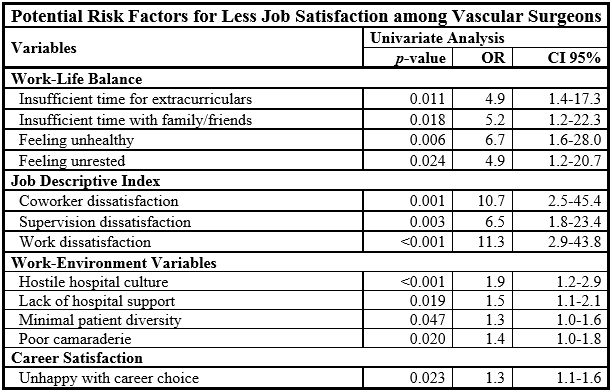Retainment of Vascular Surgeons - Prophylactic Measures to the Current Vascular Surgery Workforce Crisis
Theresa N Jackson1, Pauli Wheeler1, Michael S Truitt2, Peter Nelson1, Kelly Kempe1
1University of Oklahoma - Tulsa, Tulsa, OK;2Methodist Dallas Medical Center, Dallas, TX
BACKGROUND:
The vascular surgery workforce is in jeopardy with predicted critical shortages and declining fellowship applications. An aging United States population with increased prevalence of vascular disease, planned retirement of more than a third of the current vascular surgery workforce, and challenges recruiting are all causes of this growing shortage. This study was undertaken to explore modifiable and nonmodifiable risk factors predictive of reduced job satisfaction as a means for improving vascular surgeon retention and preventing early retirement.
METHODS:
A cross-sectional national survey of surgeons (n=1043) was conducted from September 2016 to May 2017. In addition to collection of demographic and occupational characteristics, assessment of psychological, work-life balance, work-environment, and job-satisfaction variables were obtained. Surgeons were grouped into general surgery (n=507), surgical subspecialties (n=212), obstetrics and gynecology (n=272), and vascular surgery (n=52). Chi-squared and Fisherís exact test were performed to determine significant variables between the cohorts. Vascular surgeons were recategorized as more satisfied and less satisfied using the median split. Potential risk factors for job dissatisfaction were identified.
RESULTS:
The field of vascular surgery tended to be dominated by male surgeons and had higher rates of minority groups (p<0.05). Less vascular surgery respondents were found in the Midwest as compared to other surgical specialties (p<0.001). Vascular surgeons work more hours on average than other surgical fields and were less satisfied with their work (p<0.05). On comparison of more satisfied to less satisfied vascular surgeons, potential risk factors for job dissatisfaction included unhealthy work-life balance, poor camaraderie/coworker dissatisfaction, insufficient hospital support, hostile hospital culture, discontent with supervision, minimal patient diversity, dissatisfaction with work in general, and unhappiness with career choice (p<0.05).
CONCLUSIONS:
Preventing early retirement of current vascular surgeons while improving recruitment of new specialists to the field is critical to stemming the current vascular surgery workforce crisis. Interventions need to focus on (1) improving the vascular surgeonís work-life balance, (2) increasing hospital administrationís recognition of and support for their efforts, (3) creating a collaborative work environment, and (4) identifying areas to improve personal accomplishment in work. These efforts may encourage vascular surgeon recruitment and realize a long rewarding career. 
Back to 2020 Posters
